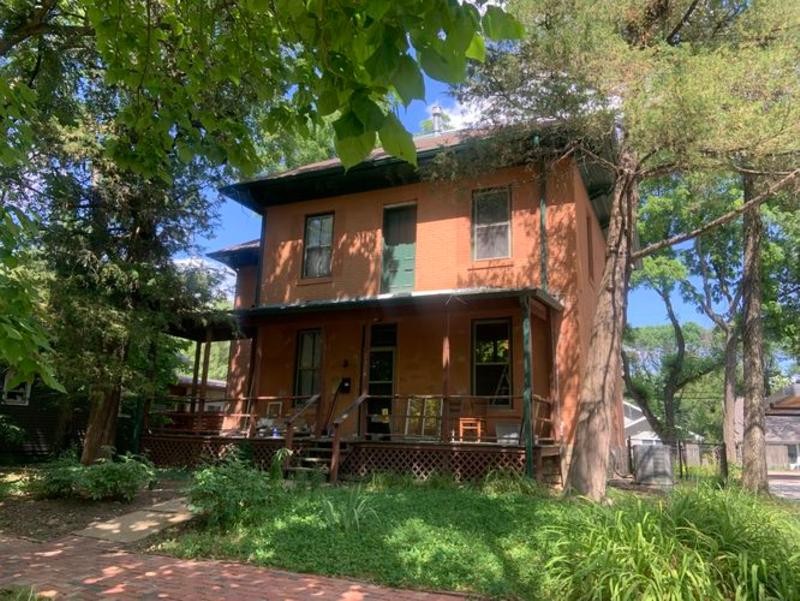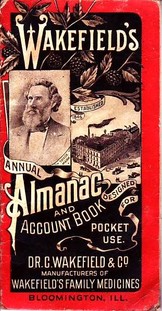Henry Waters House
Introduction
Text-to-speech Audio
This historic East Lawrence home was built in 1872 and included a cellar which was utilized by its original owner, Henry Waters, to produce and distribute patent medicines. Waters arrived in Lawrence during a significant period in the city's growth after moving from New York to Ohio and Illinois before arriving in Kansas in 1860. Many Lawrence residents were also migrants from Ohio, Indiana, and Illinois. The sizable house at that time demonstrates the popularity of patent medicines as its Italianate design was deemed by a local paper as "the finest residence in southeast Lawrence."
Images
Henry Waters House, 2021

C. Wakefield & Company Almanac

Backstory and Context
Text-to-speech Audio
Henry Waters was born in Watertown, New York in 1832. As a child, he moved with his parents to Ohio and then to Bloomington, Illinois. While in Bloomington, in 1855, he married Helen Sawyer. Henry Waters worked for his uncle Cyrenius Wakefield in the patent medicine manufacturing business for several years before moving to Lawrence in 1860 during the town's formative years (six years after the passage of the Kansas-Nebraska Act).
Waters established a branch of his uncles' C. Wakefield and Company patent medicine business in Lawrence. Wakefield and Company was part of the nation's vast patent medicine trade during the late mid- and late-nineteenth century. In 1846, brothers Cyrenius and Zera Wakefield established a business that would become C. Wakefield and Company. Zera, a med-school graduate, had success in treating an illness referred to as miasmatic fevers (or miasmatic infections). Cyrenius, a year earlier, opened a country store using Zera's money. The success of Zera's medicine led to the transition of the store to a medical laboratory and retail store to sell the drugs. Zera died shortly after forming the company, but Cryenius grew the company, whose success reflected a national trend during the mid-nineteenth century as the patent-medicine business had become a major industry. any of the medicinal concoctions of the era were fortified with painkillers like morphine, opium, or cocaine. Others simply consisted of herbs or vegetables combined with alcohol.
Remedies were available for almost any illness or pain. Although popular, many physicians and medical societies argued that the so-called remedies did not cure illness, deterred the sick from pursuing legitimate treatments, and caused alcohol and drug dependencies. Wakefield eventually sold goods in Illinois, Indiana, Missouri, Kansas, Nebraska, Iowa, and various places in the West and Southwest U.S., operating through several thousand agents such as Cyrenius' nephew, Henry Waters.
Henry Waters registered for the Civil War draft in 1863 and was in Lawrence during Quantill's Raid, a massacre that shook the growing city on August 21, 1863. During the raid, Quantrill’s Confederate soldiers burned downtown Lawrence and killed approximately 150 citizens. Lawrence had become iKansas' second-leading commercial center behind Leavenworth and the city rebounded quickly, especially after a transcontinental railroad branch line arrived in the north part of town in 1864. Three years later, the Leavenworth, Lawrence, and Galveston Railroad came to the east side of Lawrence. The railroads and subsequent population and economic growth fueled a housing boom by the late 1860s.
The house was built one year before the "Panic of 1873" led to a nationwide economic recession that affected Lawrence mightily. One attribute of the 1870s recession included difficulty in obtaining loans. During the boom, Lawrence and Douglas County had issued a total of $900,000 in bonds to support railroad construction. After 1873, this debt turned into an exceptional tax burden. The town's banks also began to fail. In 1874, a drought and grasshopper infestation devastated the farms of Douglas County. The turmoil pushed more than 1,000 residents to leave the town (and more than 2,000 throughout the county). By the time the economic situation improved, Kansas City had become the area's largest urban center and regional railroad hub. The town did not see significant growth again until the 1940s. One of the residents who fled during the economic recession included Henry Waters, who withdrew from the medicine manufacturing business and moved his family from Lawrence only five years after building his impressive, now-historic home.
After leaving Lawrence, Henry and Helen Waters lived on a farm five miles northeast of Iola, Kansas, where Henry worked at a mill. They kept ownership of the Lawrence home for a few more years until they sold the property in 1882. Helen Waters died in 1900, and Henry died in 1905, survived by four adult children (two other children died in their youth). The historic home has changed owners numerous times since the Waters sold the home in 1882, but it stands as a representation of Lawrence's early prosperity and the significance of the patent-medicine business.
Cite This Entry
Powers, Mathew and Clio Admin. "Henry Waters House." Clio: Your Guide to History. December 30, 2023. Accessed March 14, 2025. https://theclio.com/entry/176892
Sources
"History of Patent Medicine" Hagley Museum: Hagley Library. hagley.org. Accessed December 29, 2023. https://www.hagley.org/research/digital-exhibits/history-patent-medicine.
Nimz, Dale E. and Camille Wingo. "Registration Form: Henry Waters House." National Register of Historic Places. kshs.org. 2023. https://www.kshs.org/resource/national_register/nominationsNRDB/DouglasCo_HenryWatersHouse_LISTED_01042023.pdf.
Parsons, Gail Pat. “Puerperal fever, anticontagionists, and miasmatic infection, 1840-1860: toward a new history of puerperal fever in antebellum America.” Journal of the History of Medicine and Allied Sciences 52, no. 4 (1997): 424-452.
Stanley, Matthew E. "Quantrill, William Clarke." Civil War on the Western Border: The Missouri-Kansas Conflict, 1854-1865. The Kansas City Public Library. Accessed December 29, 2023. https://civilwaronthewesternborder.org/encyclopedia/quantrill-william-clarke.
Camille Wingo, https://khri.kansasgis.org/index.cfm?in=045-3010-01263
https://onbeyondholcombe.wordpress.com/2014/06/08/c-wakefield-company/

